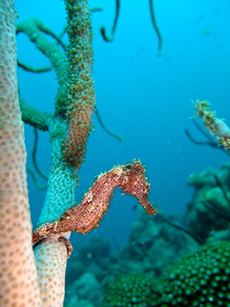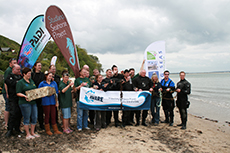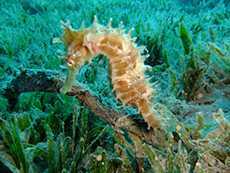




| Home | Features | Club Nights | Underwater Pics | Feedback | Non-Celebrity Diver | Events | 20 April 2024 |
| Blog | Archive | Medical FAQs | Competitions | Travel Offers | The Crew | Contact Us | MDC | LDC |

|

|
 
 |
   ISSUE 16 ARCHIVE - THE SEA DOC INVESTIGATES: SEAHORSESDr John CarlinImages by Penny WilsonThe one animal I wouldn't want to be...At the time of writing this article my wife is pregnant with our second child. She has three months left to go and she is slowly getting bigger and more uncomfortable. She complains that life is unfair, why should the female be the one that has to give birth and she wished she was a seahorse? That got me thinking about the amazingly unique creature that is the seahorse. Seahorses are closely related to pipefish and both belong to a family of fish called the Syngnathidae which is Greek and means ‘fused jaw’. The members of this family have elongated snouts, fused jaws and no teeth. The scientific name for seahorses is Hippocampus which comes from the ancient Greek ‘hippos’ meaning horse and ‘kampos’ meaning sea monster. Scientists have classified forty-seven different species of seahorse to date, although many people believe that there are more still to be discovered as divers explore further into unknown waters. Seahorses got their hippos/horse name from their equine appearance. They have something called a coronet which is a bony projection or ‘crown’ on top of their heads. The height and thickness of the coronet are used to classify the different species and since no coronet is exactly alike they can be used like fingerprints to identify specific individuals. Seahorses are normally found in shallow tropical and temperate waters throughout the world. They can be found in different marine habitats such as coral reefs, mangroves, seagrass beds and have even been seen in our own Thames estuary. Seahorse FactsSeahorses are typically small and can range in size from the smallest which is the pygmy seahorse at 1.5cm to the pot-bellied seahorse at 35cm in length. The average life span of a seahorse in the wild is one to five years. A group of seahorses is called a herd. Although seahorses are a type of bony fish, they do not have scales. Instead their skin is stretched over a series of bony plates which are arranged in rings around their body which act like a suit of armour. Now if Usain Bolt was a marine creature he wouldn’t be a seahorse. Seahorses aren’t racehorses. In fact they hold the Guinness World Record for being the slowest fish. The record is held by the dwarf seahorse which has a top speed of 1.5 metres an hour. It would take most species of seahorse about a minute to swim from the tip of your thumb to your elbow. Whilst seahorses, like other fish, use a gas bladder to regulate their buoyancy, unlike other fish and their close relatives, the pipefish, seahorses swim in an upright position. They propel themselves by a small dorsal fin on their back that flutters up to thirty-five times a second. Seahorses steer themselves with even smaller pectoral fins which are found near the back of their heads just below their gills. Seahorses have no caudal (tail) fin but they have what is a called a ‘prehensile’ tail. The dictionary definition of the word ‘prehensile’ is ‘something which is adapted for seizing, grasping or taking hold of something’. They use their tail to grasp rocks, seagrass or some other piece of substrate to anchor themselves into position. Seahorses have excellent eyesight and their eyes have evolved to move independently just like a chameleon. Scientists believe that this allows them to watch their prey whilst keeping an eye out for predators. Just like chameleons (and cuttlefish) they can change their skin colour and patterns to blend in with their environment. Some species of seahorse can even grow fleshy filaments which mimic algae or other plant life found in their habitats. Seahorses are very difficult to spot – I have only ever seen one whilst diving. Seahorses are carnivores and voracious eaters. They have no stomach and food passes through their digestive systems so quickly that they must eat almost constantly to stay alive. They use their elongated snouts to probe into nooks and crannies to suck in plankton and/or small crustaceans that drift by. When they find food they suck it up their snouts like a vacuum cleaner. Interestingly their snouts can expand if their prey is larger than their snout. Each time they suck something in they make a distinctive click which can also be heard when they interact socially as well. Mysis shrimp are a seahorse favourite. These so-called shrimp are actually a type of crustacean and are only 0.25cm long. A seahorse grazing continuously can eat over 3,000 of these ‘shrimp’ every day. Seahorses have very small territories. The female is more of a wanderer with a territory size of about 1.4 square metres whilst the male only has a territory size of 0.4 square metres and mating pair’s territories overlap. Male seahorses fight for a female’s attention and tail-wrestle (I think this must be equivalent to our own arm wrestling) and snap their heads at each other. It was thought for a long time that all seahorses were monogamous and that they mated for life. However, many species form pairs that last through a breeding season but some species will readily switch mates when the opportunity arises. Before breeding, seahorses will ‘court’ for several days. Seahorses will swim side by side, sometimes changing colour and eventually gripping the same bit of substrate to wheel around in unison in what is known as the ‘pre-dawn dance’. Nothing too strange so far but this is where it starts to get weird. The mating pair eventually engage in a true ‘courtship dance’ which can take up to eight hours. Once the female’s eggs are ready, both seahorses let go of the substrate with their tails, and snout to snout, as they drift down, the female inserts her eggs into a ‘brood pouch’ located on the front of the male’s tail in the mid-rift area. Females can deposit up to 1,500 eggs into this pouch and then once she is done she simply swims off. The male incubates the eggs for two to six weeks with the female visiting him on a daily basis. These ‘morning greetings’ last for about six minutes and are reminiscent of their courtship dances. The male tends to ‘give birth’ during the night. When the young are ready to be born, the male relaxes his pouch muscle and pumps his tail backwards and forwards to pop the baby seahorses out. This process may take a few hours and by morning he is ready to start mating again. Seahorses are among the only animal species on Earth where the male bears the unborn young and the term ‘male pregnancy’ can be used. The average number of young released can vary from five to over a thousand. The newborn baby seahorses are known as ‘juveniles’ and they are tiny replicas of their parents. They are typically less than 1cm in size (smaller than your smallest finger nail) and as soon as they are born, they are on their own. Less than 1 percent of juveniles will make it through to adulthood. They are extremely susceptible to predators and ocean currents taking them away from food and into hostile environments. So why has Mother Nature reversed the reproductive roles? Researchers are still unsure but they do know that through research, reproduction is more energetically costly to the female who loses about a third of her body weight to produce the eggs. Seahorses have been protected since 2004 by the Convention on International Trade in Endangered Species (CITES) which banned them from being imported and exported. Seahorses are under threat worldwide for three main reasons:
Overfishing and habitat destruction are having an impact on population sizes of these secretive little creatures. Are there any seahorses in our waters?There are two species of seahorse that are found on the British coastline and can be found from the Shetland Isles down to the west coast of the UK, all around Ireland and on the south coast of England. There have also been sightings on the east coast and even in the North Sea. The two species that you might see are the spiny seahorse (Hippocampus guttulatus) and the short snouted seahorse (Hippocampus hippocampus – they were quite lazy with this name). The discovery of seahorses in a place called Studland Bay in Dorset has turned this bay into a battleground where sailors, villagers and conservationists are fighting against each other for very different reasons. Now I first heard about the seahorses at Studland Bay by watching the television series ‘Britain’s Secret Seas’ where Frank Pope and Tooni Mahto went to investigate the thriving population of Spiny Seahorses living in the rare eelgrass seabeds. Did you know that eelgrass is in fact not a type of seaweed but a plant and is actually the only flowering plant underwater? The area was identified as an important seahorse breeding ground by avid naturalists, Julie Hatcher (who is the Dorset Wildlife Trust’s Awareness Officer) and her partner Steve Trewhella, who were diving on a summers day in 2004 and gently finning through the eelgrass when they spotted something strange moving. They both alerted the Seahorse Trust and forty of its divers were sent out, who identified as many as forty different individual seahorses. In fact Studland Bay has the highest concentration of seahorses found so far in Britain and so in 2010, a lottery grant of £42,000 was given to tag them with little numbered necklaces to study their behaviour. The Sea Horse Trust believe that the seahorses disappear into deep water in the winter to avoid storms but return in the summer months to the eelgrass beds to breed. The seahorses at Studland Bay face two main threats from the intensive use of the bay, through boat moorings and pleasure boat anchor(s/ing), threatening this fragile eco- system. During the summer months over three hundred boats come to visit this bay during the sunny weekends. The chains from the moorings swing and scour patches of eelgrass creating ‘desert’-like conditions on the seabed as the tide goes in and out whilst anchors kill the eelgrass and create bare furrows as they are dropped in and pulled out. One compromise could be eco-friendly moorings that rise and fall with the tide but some local villagers say that these are expensive, need maintenance every year and boat insurers have to approve them. In fact, some say that the eelgrass beds rather than disappearing, are in fact expanding towards the beach. In an effort to get some answers a survey has been commissioned and is currently underway where two similar areas in the bay are being studied and compared. One area allows anchoring to continue as usual and a second area which is now a ‘no anchor zone’ and is marked with six yellow buoys. I was recently asked by Kevin Craddock, owner of Flippas-n-Fins in Dorset to come in and help with a ‘Dive Against Debris’ Project AWARE event at Studland Bay. I jumped at the chance and I was introduced to Julie Hatcher who gave an amazing presentation about the Studland Bay seahorses and the eelgrass beds. Julie, together with the dive organiser Mark Ninnim (Flippas-N-Fins), outlined the strict protocols for diving in areas where there may be seagrass and seahorses. These protocols can be found at on the Dorset Wildlife Trust website. The following day I joined the Flippas-N-Fins diving team, where, with twenty other PADI divers, we were organised into buddy pairs for a series of co-ordinated dives to clear the seabed of debris and record any wildlife that was encountered. The debris collected was documented, correctly disposed of and the data was sent to Project AWARE. It was a fantastic event with plenty of wildlife and pleasingly very little rubbish. I saw some large pipefish but no seahorses, so in my best Arnold Schwarzenegger impression – ‘I’ll be back’. So to wrap this article up and answer the following question; there is one creature I wouldn’t want to be... despite it being amazingly unique, but mainly due to the ‘male pregnancy’ and whole giving birth malarkey... ... and that is a seahorse. |